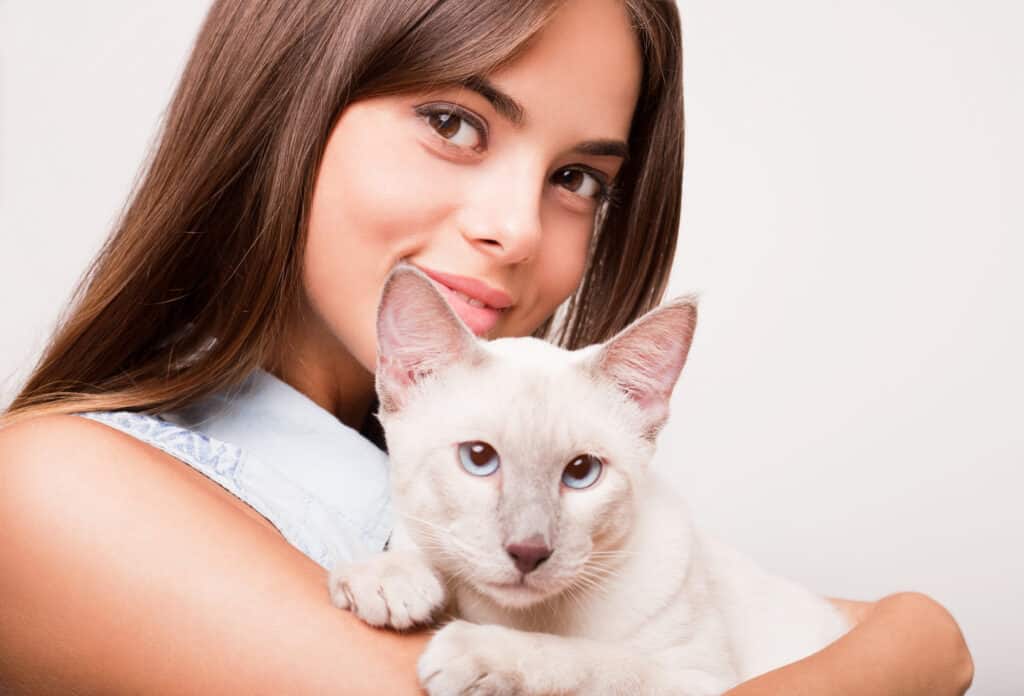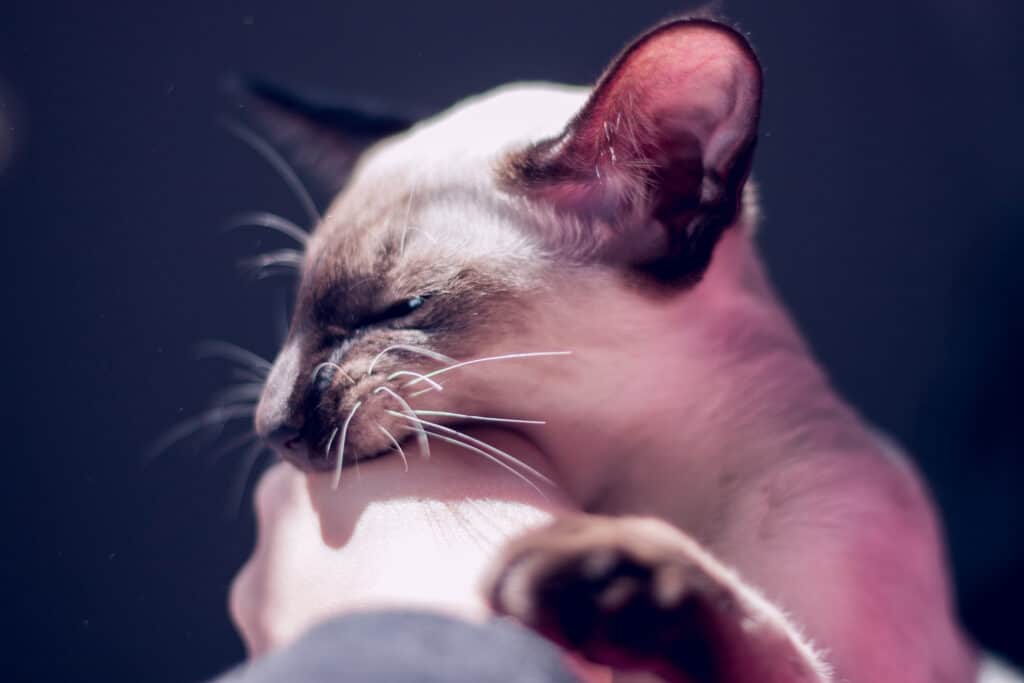Siamese cats are sweet, intelligent, talkative, and very entertaining pets to own, but above all, they possess one of the most interesting genetic traits of all cats; their beautiful, distinctive fur colors.
Siamese cats are most well-known for their distinctive fur coloring. Although there are 32 different documented color variations in Siamese cats, the differences are often very slight. For casual observers, it might be hard to distinguish the differences because they are so subtle.
What determines the fur color of a Siamese cat?
Siamese breed cats get their distinctive color shades from a gene that is unique to this breed, called the Himalayan Gene.
The Himalayan gene causes temperature-reactive albinism, which changes the color of the cat’s fur based on their local body temperature. The fur in cooler parts of the cat’s body becomes darker while the hotter parts of the cat turn lighter.
This causes the darker colors in Siamese cats towards their ‘points’; hence they are referred to as ‘color points’.
To describe color variations in Siamese bred cats, we commonly refer to their color points such as Cinnamon point, Apricot point, Lynx point, and so on.
When do Siamese kittens get their colors?
Siamese kittens are completely white or cream-colored when born. After about one month, their color points will be distinguishable and gradually become more apparent as they age.
Their final color depends on the genetic make-up of their parents but can change over time.
If the parents have well-defined color patterns with high contrast, you’ll be able to see their colors form quite early. With the more muted colors like a Lilac Point or a Flame Point (orange) Siamese kitten, it may take longer for the colors to appear.
Do Siamese cat colors change over time?
As mentioned, the Himalayan gene is sensitive to temperature. Because of this, a Siamese’s color can change when they are warmer or cooler.
This happens, for example, because of seasonal changes, changes in diet, or when they have a fever.
Color changes can also be an indicator of the cat’s health. Certain diseases or conditions cause color changes in Siamese cats, such as liver diseases, urinary tract problems, or hyperthyroidism.
If you detect a sudden and unexplained color change in your Siamese, consult your vet and rule out any problems with your cat’s health.
How Many Color Variations of Siamese Cats Exist?
The answer to the question of how many different color variations for Siamese cats exist may surprise you.
Although there are up to 32 documented color variations in Siamese cats, the Cat Fanciers Association (CFA) only officially recognizes four distinct variations as purebred Siamese. These are: Chocolate Point, Seal Point, Lilac Point, and Blue Point.
According to the CFA Breeding standard, the others are not considered ‘pure’ Siamese because these variations were often created by cross-breeding with other breeds.
For the purpose of this article, we will describe the most common color variations in Siamese cats, including the ones that are officially recognized by the CFA.
Siamese Cat Coat Color Chart
The below table gives a quick overview of the most common Siamese color variations. Below the table you will find pictures for each of those variations with a description.
| Name | Color Points | Recognized by CFA? |
|---|---|---|
| Blue Point | From light gray to slate blue. | Yes |
| Seal Point | Light brown, edging to darker brown, even close to black. | Yes |
| Lilac Point | Very light lilac with pink-ish undertones. | Yes |
| Chocolate Point | The darkest of Siamese cats with darker brown, going on black points. | Yes |
| Fawn Point | Pale brown with hints of pink (often confused with Lilac Point). | No |
| Caramel Point | Warm creamy brown with darker pinkish-gray towards the points. | No |
| Cinnamon Point | Warm orange-like brown that gets darker towards the points. | No |
| Flame Point | Comes in different shades of orange, ranging from very slight to Tabby-like. | No |
| Tortie Point | Come in different color variations, depending on the color of the tortoiseshell cat they were bred with. | No |
| Apricot Point | Very pale orange color, often with ringed tail or striped patterns. | No |
| Cream Point | Pale orange color that is often present across the entire body and not noticeably darker towards the points. | No |
Different Types of Siamese Cats and Their Colors
Out of the 32 distinctive and officially recognized type of Siamese cats, several have just very slight variations and are often only recognizable by the trained eye.
We’ll look at the most common and most popular types of Siamese cats.
Blue Point
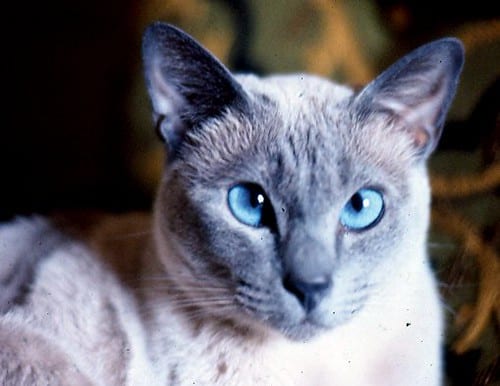
Blue point Siamese Cats have a beautiful and ‘luxurious’ grayish to blue or slate color that combines very well with their often bright blue eyes.
Blue points are among the most popular Siamese color variations.
Their blue point often darkens with age, giving them an even more distinctive look.
Seal Point
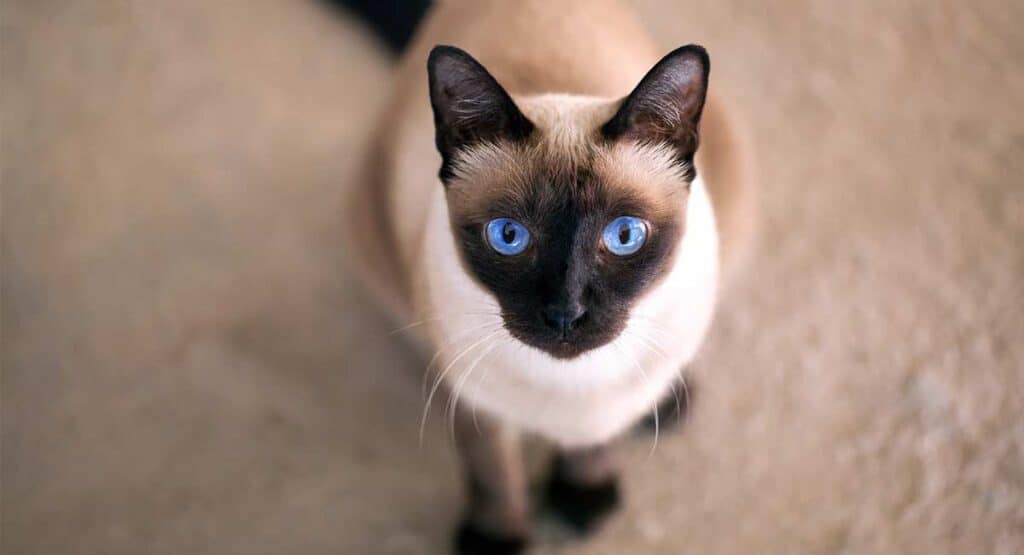
Seal point siamese cats are usually light brown, edging toward dark brown or black points, and are probably the most well-known color variation.
Interestingly, purebred seal point siamese cats are genetically black cats; however, due to the Himalayan gene, their black is subdued and only comes through in their points.
The seal point often has a creamy body color that can be slightly darker than other Siamese.
Lilac Point
Lilac points are among the lightest variations with a white to light cream-colored body and lilac points with slight pinkish undertones.
Their color usually doesn’t darken with age.
Fawn Point
Fawn Siamese cats are often confused with lilac points because the difference is very slight. Like the lilac points, their bodies are off-white, and their points are pale brown to pinkish.
Caramel Point
Caramel Points usually have a ‘warm’ creamy color that varies from light on their bodies to darker pink-gray towards their points. Their points are often less pronounced compared to other Siamese color points.
Chocolate point
Chocolate points are similar to seal points were it not that their whites are whiter and their points are much darker, resulting in maximum contrast between dark and light. The chocolate points are dark brown or even almost black.
Cinnamon Point
Cinnamon points look like a chocolate points to the untrained eye. The difference is that Cinnamon points have a warmer orangey-light brown color that is not as dark towards their points.
Orange Siamese Cats, a.k.a. Red Point, Flame Point, or Tabby Point
It’s often debated whether Orange Siamese cats, a.k.a. Flame Points are pure Siamese because they are created by breeding a Siamese with a Tabby or Tortoiseshell.
Siamese Tabby mix cats have a warm brownish to red or orange color. They are fairly light at the points and can often be recognized by their ringed tail, tabby stripes, and ‘M’-shape on their foreheads, which they inherited from their Tabby or Tortoiseshell side.
Red Tabby points are most common, but there are other color variations such as a chocolate tabby point, caramel tabby point, cinnamon tabby point, or cream tabby point.
Suggested reading: Everything About Flame Point Siamese Cats
Tortie Points
A Tortie Point is a variation of the tabby point but then crossbred with a Tortoiseshell cat. Tortie points come in different color variations, such as a cinnamon tortie point, a caramel tortie point, or a fawn tortie point.
Like Tabby point Siamese, a Tortie point is also not considered a pure Siamese,
Cream Point
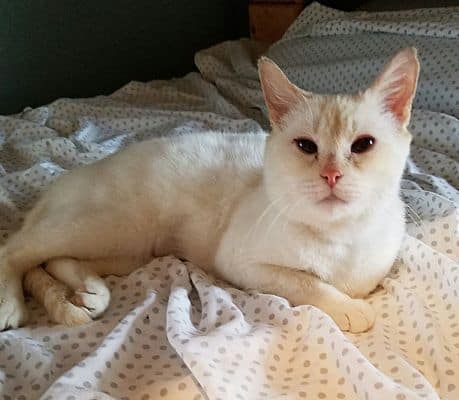
Cream points are not officially recognized as being Siamese. They are created by crossing a Siamese with an Abyssinian or red Shorthair, hence their red/orange color.
Their markings are very pale, and there is little variation in the contrast between their bodies and color points.
Apricot Point
Apricots are considered variations of Cream Points and, therefore not purely Siamese. Apricot Siamese have an orange coloration but are often more pale with little contrast between their bodies and color points.
They often exhibit ringed tails or mottled/striped patches, which they inherited from their tabby-side.
Is there such a thing as a black Siamese cat?
People often ask us if completely black Siamese cats exist because they came across a black cat with all characteristics of a Siamese; however, it is entirely black.
It’s an interesting question because these people are right. However, these cats are missing the distinguishing feature that makes Siamese cats Siamese.
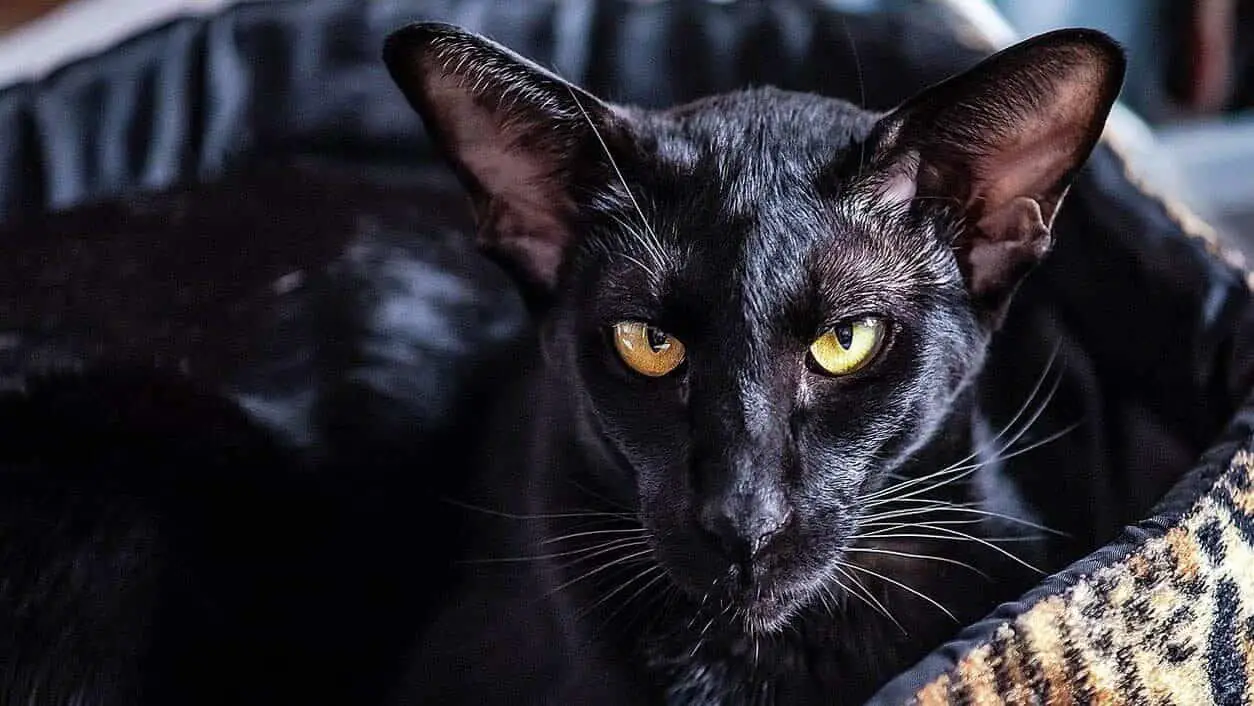
Black Siamese cats do not exist because they miss the Himalayan gene, which distinguishes Siamese cats from other breeds. This gene is responsible for their color gradients, known as color points.
The chances are that if you come across a black Siamese cat, you’re probably looking at an Oriental cat that is similar to a Siamese but without the Himalayan gene.
Read our full article about black Siamese cats here.
Why are orange Siamese cats often males?
Orange female Siamese cats are relatively rare, but it isn’t an impossible coloration.
This doesn’t just apply to Siamese cats; orange females of any breed are not as common as males. It’s not impossible, but orange-colored females are more likely to only have some orange accents rather than a full orange coat.
You may be wondering why female cats are less likely to be orange than their male counterparts? It’s all right down to the genetics of color.
It’s all about the genes
Scientists are reasonably certain that cat color is closely linked to genes on the X-chromosome.
Since female cats have two X chromosomes while male cats only have one (they have an X and Y chromosome, just like human males), female cat colors are often harder to predict than male cat colors.
Cat color genes are further complicated because two different color genes won’t necessarily be strictly dominant or recessive. Some color genes will combine into a mixed coloration that only exists when both genes are present. Other genes are more dominant and can become dominant over the other genes.
How a female Siamese cat turns orange
Many female cats with one orange gene will express calico cats, tortoiseshell cats, or completely orange-free colors.
Female cats that are lucky enough to get two copies of the ginger fur gene will surely be orange, a bit like human redheads!
Roughly 1 in 5 female cats that carry the orange gene will have partly or fully orange fur. On the other hand, because male Siamese cats don’t usually have a competing color gene, they will definitely inherit the orange color, sometimes with white accents.
Are Red Point Siamese Cats Rare?
A red point Siamese cat is beautiful, loving, incredibly active, and talkative. But they aren’t widespread.
This is because Red Points or Flame Points, are not considered purebred Siamese. Their red color is inherited from a domestic Tabby cat or Tortoiseshell.
Because of this, many crossbred Red Points are not officially registered as Siamese by the breeder. Most breeders don’t set out to purposely create a Red Point as it’s considered an impurity.
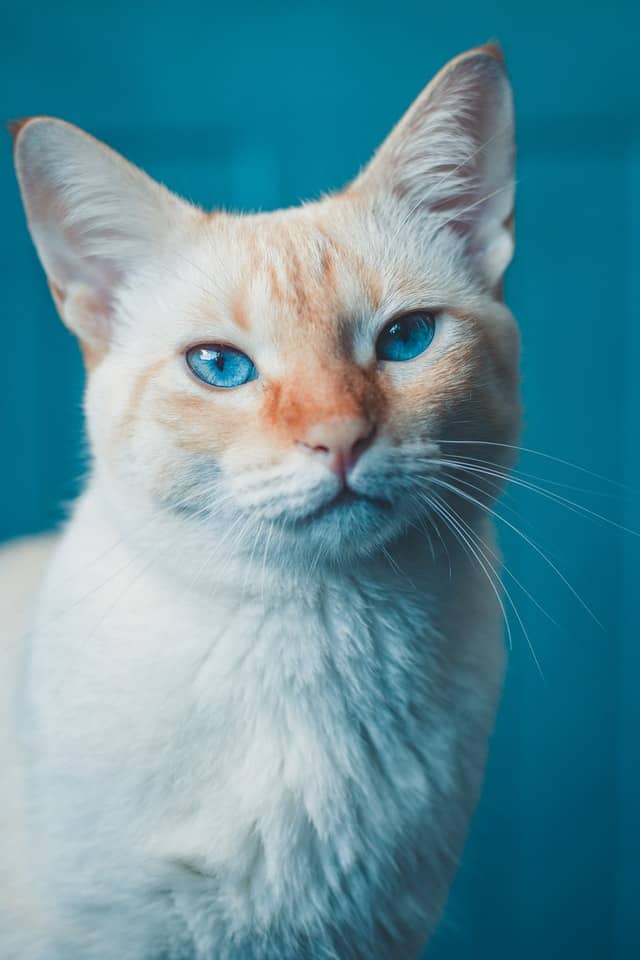
Red Points are beautiful, though. If you are deadset on getting a Red point cat, it’s good to look for Siamese cat shelters. Sadly, many Siamese ends up in shelters because their owners don’t realize how high-maintenance Siamese cats can be.
Because Red Point Siamese are relatively rare, it might take some patience to find one, and you might need to travel to get one.
How do Siamese cats cost to purchase?
The price for a Siamese cat is dependent on a few factors, such as their age, the breeder, and how rare their color variation is. As a rule of thumb, Siamese kittens can usually be found for $600-$800, while a healthy adult goes for $1000-$2500.
Yes, if you’re looking to own an orange Siamese cat, prepare yourself for a hefty price tag. There, however, are some ways you can get one for significantly less.
Adopting cats from a shelter is usually cheaper than purchasing them from a breeder. However, many shelters charge more for rare cats and see it as an excellent opportunity to help cover their operating costs.
It’s not necessarily a bad thing that Siamese cats are more expensive. This also creates a barrier for potential owners who don’t know what to expect and how to care for a Siamese cat.
How to find a good breeder?
Google is a great starting point when looking for a breeder, but be careful. There are quite a few clandestine breeders around. For your (and your cat’s) sake, do your due diligence and make sure everything is on the up and up.
Planning to visit a breeder for the first time and don’t know what to look for?
Have a look at this article from yourcat.co.uk about what to expect, things to look out for, and questions to ask.
How to tell if a cat is an authentic Siamese cat?
Although their features are unique, sometimes it can be challenging to determine if a can is really a Siamese cat.
There are few cat breeds that look similar to Siamese cats, such as Oriental cats, Javanese cats, or Himalayan cats.
Luckily there are a few ways to tell if you came across one of these rare color combinations. Especially since orange Siamese cats are very uncommon, it’s essential to know how to recognize one when you see one.
This Siamese cat recognition guide can help you determine what kind of cat breed you have.
Most distinctive characteristics
Siamese cats are one of the more distinctive breeds out there, with many clearly defined color markings that make them stand out. They also tend to have a unique personality, though not every Siamese cat will love exercise or spend their whole day talking.
Siamese cats have blue eyes, and most of their fur (for most colors) is creamy white, with more color in the points. When saying ‘points’, we refer to their face, the tip of their tail, paws, paw pads, and nose.
Some Siamese cats will also have some light coloring along their back. They can also have a tapered tail that ends into a distinct point.
Some Siamese cats still have some of their older traits, like crossed eyes or a crooked tail. However, since these characteristics are considered undesirable, most breeders have focused on breeding this out.










